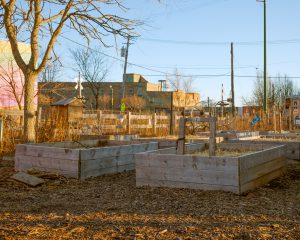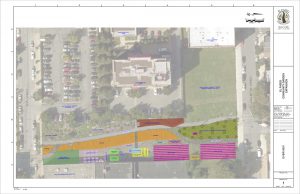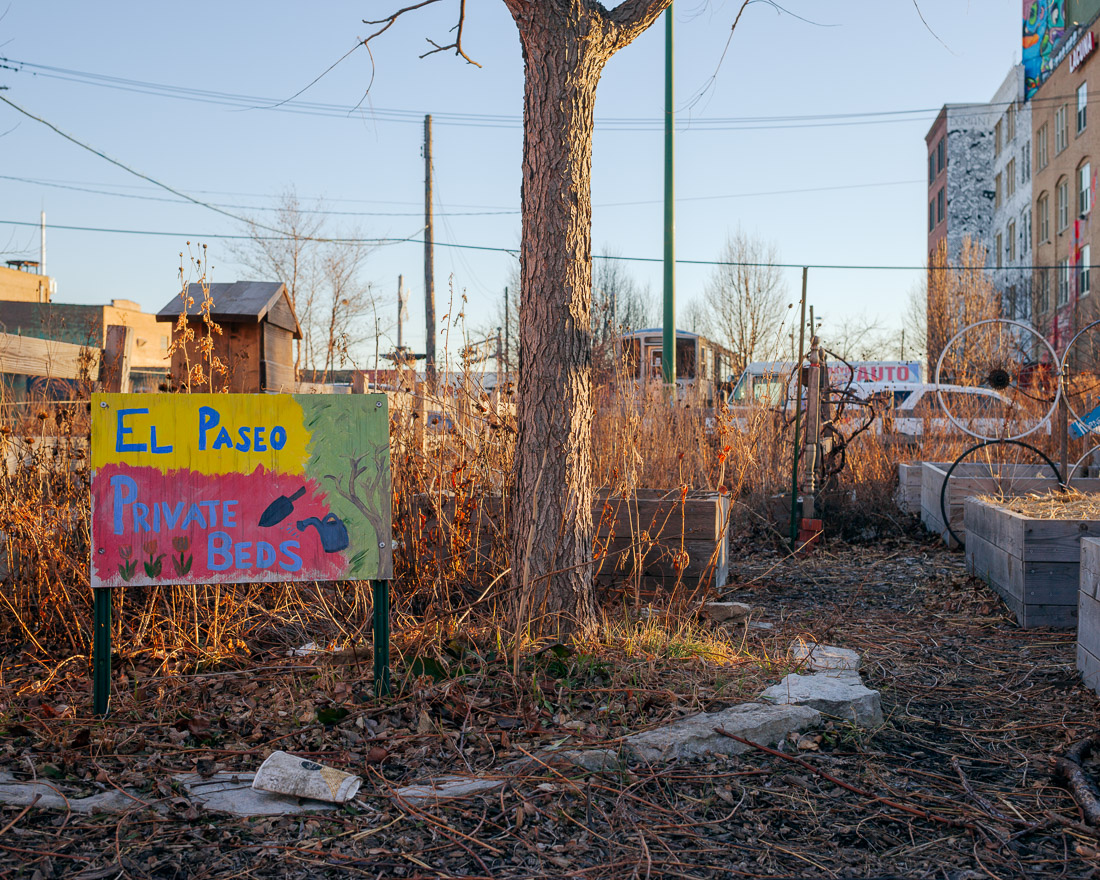By Nathan Ouellette
Medill Reports

The raised plant beds that dot the wood chip-covered pathways of Pilsen’s El Paseo Community Garden begin sprouting vegetation in early spring.. These community and volunteer-run growing stations are not merely an aesthetic choice but a necessity.
Years of lead smelting and other industrial usage has left the soil of the Sangamon Corridor – a section of land running south from 16th Street along Sangamon Street to 21st – inundated with various heavy metals such as lead and arsenic. The El Paseo garden’s use of raised beds responds to their proximity along the corridor and prevents the leaching of toxins from the soil to the growing vegetation.

“That’s why we have raised beds,” said Antonio Acevedo, community garden co-director. “There are some areas that did not have to be remediated, since they were below the EPA’s safety levels. However, we take safety precautions like using agricultural cloth barriers, wood chips and raised beds with fresh soil for edible plants and food. There is no danger with the food grown. The possible danger is if the soil in the ground is disturbed (in the unremediated areas) and ingested”
BNSF railway no longer utilizes the tracks along its Sangamon right-of-way; Loewenthal Metals Corporation had ceased lead and zinc smelting at their former industrial site on Cullerton Street in the 1950’s before a fire razed the facility. Land restoration gained little attention in Pilsen until 2016 when the city broke ground on the El Paseo Trail, a bike path that would lead from Pilsen to Little Village along the abandoned BNSF right-of-way which the railroad still owns.
The El Paseo Trail, sharing the name of the community garden near its origin at Cullerton and Sangamon Street, had been in planning since 2006. The ultimate goal was to provide a pedestrian path along the abandoned industrial corridor for recreational activities such as biking, walking and running, lined with native plantings along the stretch. Carrying the project to fruition required remediation of the soil along the proposed path.
“The [Federal] EPA came in, hired contractors, and dug down three to four feet, removed all the soil from 21st Street all the way up to 18th,” Acevedo said. “They put in a geotextile fabric-barrier, gravel, another barrier and topsoil. Everything on the other side [of the garden] is now fresh, clean soil.”

Complications ensued and stalled further construction, however, as the city, and the railroad negotiated payment for the remaining cleanup. This past January marked the completion of the project’s most recent progress, involving remediation from 18th Street to 16th Street, which now waits for the paved path to be installed.
“BNSF funded the cleanup of the lead-contaminated soil under EPA oversight,” EPA Press Officer Rachel Bassler said in an email. “The City of Chicago is working with BNSF to acquire the property so that the El Paseo project can move forward.”
Remediated land only extends between 16th and 21st Street and, amid continuing negotiations, there remains no foreseeable completion date for the project, according to BNSF and a spokesperson with 25th Ward Alderman Danny Solis’s office.
“BNSF has worked with the EPA to remediate soil on our right of way in the Pilsen community,” a spokesperson with the railway company said. “We will continue to work with our partners to meet community needs.”

While the city and the railroad negotiate further construction on the bike path, the volunteers at the El Paseo Community Garden have plans of their own.

Bolstered by the renewed land from Cullerton to 21st, Acevedo intends to grow beyond the raised planting beds of the current garden and extend its roots along the entire block with the goal of providing more of nature’s benefits to the community.
“We [already] do lots of community events,” Acevedo said. “We host Yoga Wednesdays, Meditation Thursdays, all taught by local residents<” he said. “We have community potlucks, planting days and garden workshops open to the public.”

The garden’s current expansion plans include two remediated plots for row crops including tomatoes, peppers, leafy greens, various root vegetables and cucurbits, a compost area, a food forest and permaculture garden with space for beekeeping, and open grass community space for those daily designated events.
Plans for an area adjacent to the former Loewenthal Mills site call for a nature play garden – a natural jungle gym created from building blocks found in nature – aptly juxtaposing the once toxic industrial plot against the garden’s mission for environmental consciousness.
“Think of fallen trees, logs, stumps – using logs as stepping stones and teeter-totters – not playground equipment, but something you’d find in the forest,” Acevedo said. “[We would] basically recreate sort of a nature garden. That is going to happen next year.”
Efforts by Acevedo and garden volunteers have allowed much of this plan to begin moving forward due to an expanded lease that gives the garden the opportunity to extend to the new areas, despite a desire to wait for the completed bike path over concern that construction may damage the garden
Still, Acevedo and the El Paseo’s volunteers remain hopeful.
“This is really far down the road, but if we get a greenhouse or some sort of indoor facility, then we can run programs all year round, especially educational programs for all the kids in the neighborhood,” said Noah Frazier, one of the leaders of the collective garden space. “There’s always kids hanging out in the garden because it’s such a fun place to be in the summer, but it would be great if it were also accessible in the winter and had more to offer in terms of running workshops.”
Frazier has only been volunteering at the garden since the spring but recognizes a sense of reinvigoration among gardening veterans with every new development.
“They see that it’s not just any garden,” Frazier said. “They’re trying to keep the Pilsen spirit alive.”


